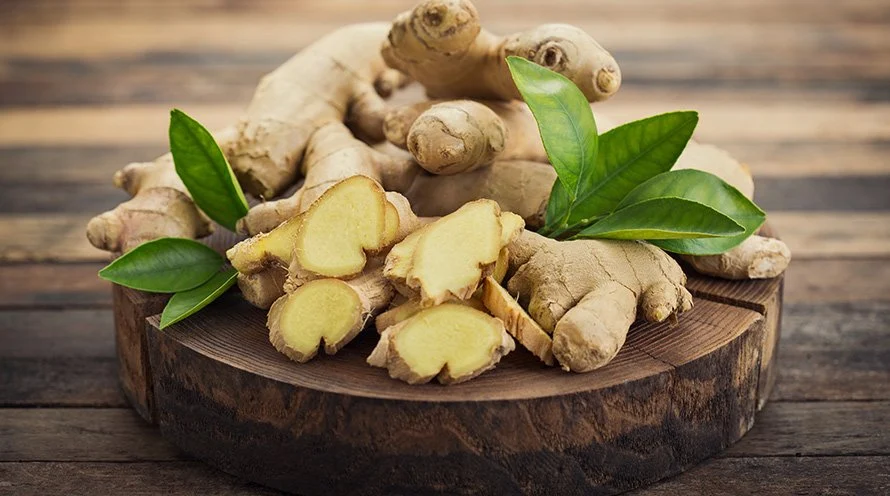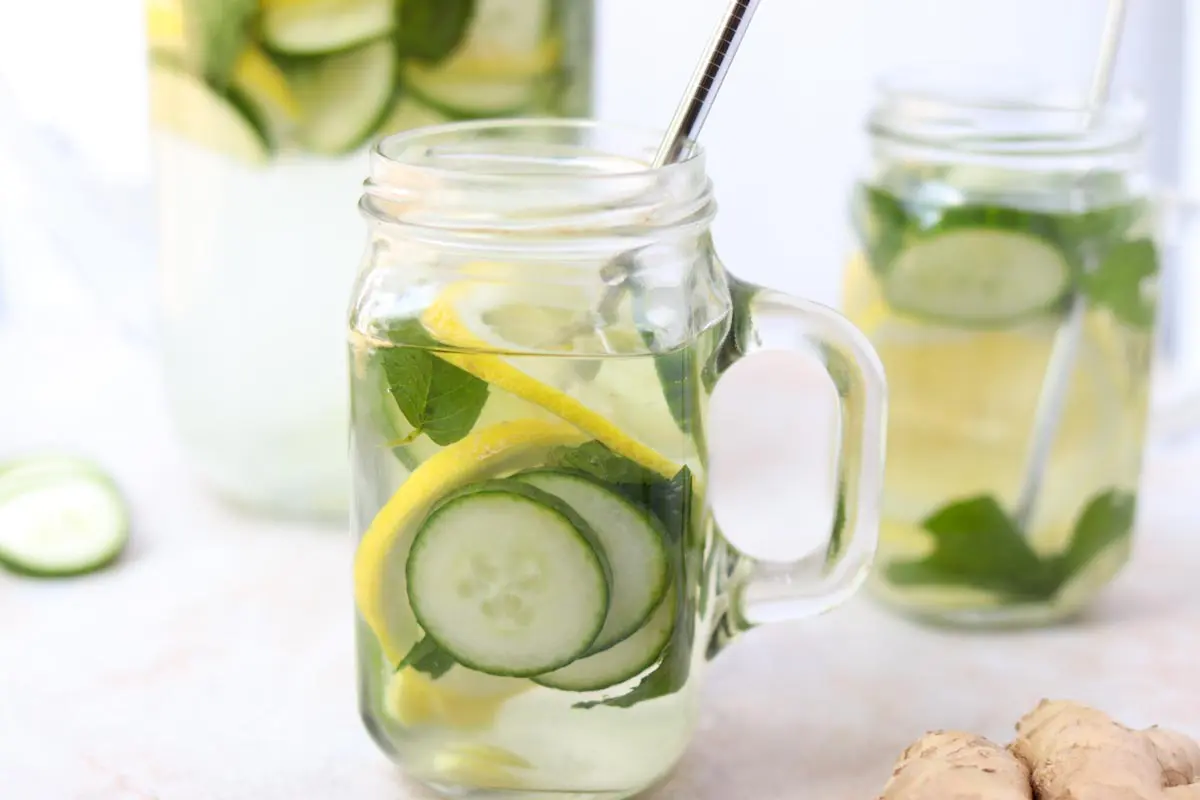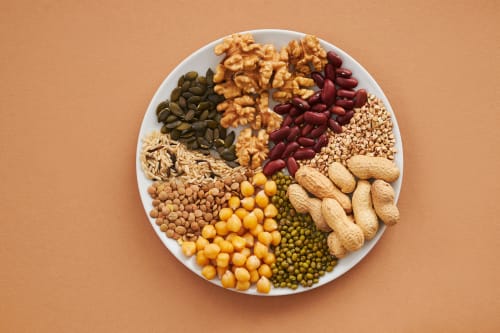Ginger Tea: A Natural Remedy for Period Bloating – An Indian Youth’s Guide
Menstrual cycles can be challenging, with cramps, mood swings, and the infamous bloating making it hard to function at your best.
If you’re an Indian youth juggling studies, work, and social commitments, the added discomfort of period bloating can feel like an unwelcome guest. But what if the solution lies in your kitchen?
According to age-old wisdom—something our mothers have always known—ginger tea is a simple, effective remedy for easing period bloating.
This blog delves into why ginger tea is a go-to solution for menstrual bloating and how it aligns with the lifestyle of Indian youth. Let’s explore how this golden elixir can make your period days a little easier.
Understanding Period Bloating
Period bloating occurs due to hormonal fluctuations, particularly increased levels of estrogen and progesterone. These hormones cause water retention, which leads to a feeling of puffiness or tightness, especially around the abdomen.
While bloating is a normal part of the menstrual cycle, it can be uncomfortable and frustrating.
Why Do Indian Youth Face More Challenges?
As a young Indian, you may already have a hectic lifestyle, balancing academics, work, or other responsibilities. Add to this the cultural expectations and dietary habits that sometimes lean heavily on processed foods, salt, or caffeine—all of which can exacerbate bloating.
Furthermore, in many Indian households, discussing menstruation with male family members is still considered taboo. Some deeply ingrained cultural practices also restrict women during their menstrual cycle, such as not allowing them to enter the kitchen or sleep in a proper bed.
These emotionally distressing practices can, in turn, cause stress, leading to the release of cortisol, a stress hormone that worsens physical discomfort, including bloating.
This is where natural remedies like ginger tea can make a significant difference.
Why Ginger Tea Works Wonders for Period Bloating
1. Anti-inflammatory Properties
Ginger contains powerful anti-inflammatory compounds called gingerols and shogaols. These help reduce the inflammation in the gut, relieving bloating and soothing abdominal discomfort.
2. Promotes Digestive Health
Bloating often stems from digestive issues like slow metabolism or gas buildup. Ginger tea stimulates the digestive enzymes, aiding in faster digestion and reducing gas.
3. Diuretic Effect
Ginger tea has mild diuretic properties that help flush out excess water from the body, reducing water retention and puffiness.
4. Hormonal Balance
Ginger may also play a role in regulating hormones, helping reduce the severity of period symptoms, including bloating, cramps, and mood swings.
5. Warmth and Comfort
A hot cup of ginger tea provides warmth and relaxation, which can ease period discomfort and elevate your mood during challenging days.
Ginger Tea for Period Bloating: Step-by-Step Approach with External Resources
Here’s how you can implement ginger tea as a remedy for period bloating, broken down into actionable steps. Additionally, external links provide deeper insights and credibility.
Step 1: Understand the Science Behind Ginger and Menstrual Health
Before diving into remedies, it’s helpful to understand why ginger is effective for bloating and menstrual discomfort. Research confirms its anti-inflammatory, digestive, and hormone-regulating properties.
External Resources:
Step 2: Gather Ingredients
Head to your kitchen or a local grocery store to gather the following ingredients:
- Fresh ginger root
- Water
- Optional: honey, lemon, or additional spices like cardamom
External Resources:
- BBC Good Food: Why Fresh Ginger Is Better Than Powder
- Times of India: Ginger Benefits in Indian Cooking
Step 3: Prepare Ginger Tea
Follow this quick recipe:
- Boil 2 cups of water in a pan.
- Grate or thinly slice 1-2 inches of fresh ginger.
- Add the ginger to the boiling water and let it simmer for 5-7 minutes.
- Strain the tea into a cup.
- Add a teaspoon of honey or a squeeze of lemon for extra flavor.
External Resources:
Step 4: Drink Responsibly
Consume ginger tea once or twice a day during your menstrual cycle. Avoid drinking excessive amounts, as it can lead to acidity or heartburn in some individuals.
External Resources:
Step 5: Pair Ginger Tea with Lifestyle Adjustments
For maximum relief, complement ginger tea with:
- Hydration: Drink at least 2-3 liters of water daily.
- Diet: Include fiber-rich foods and avoid salty snacks.
- Light Exercise: Try yoga or gentle stretching exercises.
External Resources:
Step 6: Monitor the Results
Keep track of how ginger tea affects your period symptoms over a few cycles. If the bloating significantly reduces, incorporate it into your routine. However, if symptoms persist, consult a healthcare provider.
External Resources:
- WebMD: When to See a Doctor for Menstrual Symptoms
- National Library of Medicine: Gut Health and Hormonal Cycles

Quick Overview of the Steps to Use Ginger Tea for Period Bloating
- Understand the Science Behind Ginger
Ginger’s anti-inflammatory and digestive properties make it effective for easing period bloating. Its ability to regulate hormones also helps reduce discomfort during your menstrual cycle. - Gather the Ingredients
You’ll need fresh ginger root, water, and optional ingredients like honey, lemon, or cardamom for added flavor. - Prepare Ginger Tea
Boil 2 cups of water, add grated or sliced ginger, and let it simmer for 5-7 minutes. Strain into a cup and add honey or lemon if desired. - Drink Responsibly
Drink ginger tea once or twice a day during your period, but avoid overconsumption to prevent acidity or heartburn. - Pair with Lifestyle Adjustments
Stay hydrated, eat fiber-rich foods, and engage in light exercise like yoga to enhance the effectiveness of ginger tea in reducing bloating. - Monitor the Results
Track how your symptoms change over a few cycles. If bloating decreases, continue using ginger tea. If symptoms persist, consult a healthcare provider.
By following these simple steps, you can naturally manage period bloating and stay connected to time-tested, culturally rooted remedies.
When and How Often Should You Drink Ginger Tea?
For best results, drink ginger tea:
- 1-2 times a day during your menstrual cycle, especially when bloating is at its peak.
- First thing in the morning on an empty stomach or in the evening for a calming effect.
Avoid overconsumption, as too much ginger can sometimes cause heartburn or acidity.
The Cultural Connection: Wisdom Passed Down
In Indian households, natural remedies like ginger tea have been trusted for generations. Whether it’s curing a sore throat or soothing an upset stomach, ginger holds a revered place in Ayurvedic medicine. Our mothers and grandmothers often know the value of these age-old practices, even when modern science is just catching up.
As Indian youth, incorporating these traditional remedies into your lifestyle allows you to stay connected to your roots while addressing modern-day health challenges.
Why Ginger Tea Fits the Lifestyle of Indian Youth
- Quick and Easy to Prepare: With minimal ingredients and effort, ginger tea can be made in minutes, making it perfect for busy students or young professionals.
- Affordable and Accessible: Ginger is readily available in most Indian kitchens, making this remedy cost-effective and convenient.
- Customizable Flavor: You can experiment with add-ons like cardamom, cinnamon, or tulsi to suit your taste preferences.
- Holistic Wellness: Beyond bloating, ginger tea helps with cramps, nausea, and even stress—common challenges faced by Indian youth.
Additional Tips to Combat Period Bloating
While ginger tea is an excellent remedy, combining it with a healthy lifestyle can enhance its effects:
- Stay Hydrated: Drink plenty of water to prevent water retention.
- Reduce Salt Intake: Avoid salty snacks, which can worsen bloating.
- Eat Fiber-Rich Foods: Include fruits, vegetables, and whole grains in your diet to promote digestion.
- Exercise Gently: Yoga and light stretches can help alleviate bloating and cramps.
- Limit Caffeine: Replace coffee with herbal teas like ginger, chamomile, or peppermint during your period.
Conclusion: A Cup of Comfort
Ginger tea is more than just a beverage—it’s a cup of comfort, offering relief from period bloating and other menstrual woes. As an Indian youth navigating the complexities of modern life, embracing this traditional remedy can be a game-changer for your overall well-being.
The next time your period brings along bloating, listen to your mom’s advice and brew yourself a warm, soothing cup of ginger tea. It’s a small act of self-care that can make a big difference.
So, why wait? Give ginger tea a try and experience its magical benefits for yourself!
Disclaimer:
The information provided in this blog is intended for general informational purposes only. While ginger tea has been traditionally used in Ayurvedic medicine and has some proven health benefits, it should not be considered a substitute for professional medical advice, diagnosis, or treatment. Always consult with a healthcare provider before making any significant changes to your diet, especially if you have underlying health conditions or are taking medications.
Individual results may vary, and excessive consumption of ginger can lead to side effects such as heartburn or gastrointestinal discomfort. Please consume ginger tea in moderation.
The external resources linked in this article are for reference purposes and do not necessarily reflect the views or recommendations of the author.
-

Mastering the Art of a Sincere Apology: A Guide to Rebuilding Trust
Many people find saying ‘sorry’ challenging. It can sometimes feel uncomfortable, vulnerable, or even unnecessary, especially when emotions run high.
However, a heartfelt apology has the power to mend relationships, rebuild trust, and show true strength of character.
In this guide, we’ll explore what makes an apology sincere, how to craft one that resonates and the steps you can take to turn a difficult moment into an opportunity for growth and connection.
Before the Apology
Preparing Yourself Before Apologizing
Preparing yourself before apologizing can make a huge difference in the outcome it brings.
A thoughtful, well-prepared apology can sound authentic and meaningful, while a rushed or insincere one might cause more harm than good.
1. Acknowledge Your Mistake
Recognizing the error you made and taking full responsibility for your actions is the first and most crucial step to delivering an authentic apology.
Before apologizing, ensure that you clearly understand your mistake and genuinely want to make things right.
As Gary Chapman and Jennifer Thomas state in their book The Five Languages of Apology, “The best apologies are those that are heartfelt and specific.”
Taking responsibility shows maturity and sincerity, and it sets the foundation for rebuilding trust with the listener.
Remember, an apology only feels authentic if you’ve taken the time to reflect on your actions and their consequences. Apologizing without this understanding can come across as hollow or insincere.
2. Understand the Impact
While apologizing is often the right thing to do, it’s important to consider the context.
Not every situation requires an apology, even when you feel you’ve made a mistake. There are instances where an apology might be used against you, such as when someone is attempting to manipulate or embarrass you.
Additionally, your reaction in a particular moment might stem from years of unresolved pain or harm caused by the other person. If that’s the case, it’s essential to assess the situation carefully. Ask yourself:
- Does this person genuinely deserve my apology?
- Is my reaction tied solely to this incident, or is it influenced by past experiences?
If you determine that you were in the wrong, focus on understanding the effect your actions have had on the other person.
Consider how it has impacted their feelings, trust, and well-being. Empathy is key—put yourself in their shoes and try to see things from their perspective.
This will help you craft an apology that not only acknowledges your mistake but also shows that you care about repairing the harm caused.
Here’s a refined and structured version of your content, enhancing clarity, grammar, and flow:
3. Choose the Right Time and Place
The timing and location of your apology can significantly influence how it is received. Consider the personality and preferences of the person you’re apologizing to when deciding on the setting.
- Private vs. Public Apologies:
If the person values privacy, choose a quiet and private space to express your feelings. However, if you’re dealing with someone who might manipulate or take advantage of a private apology, a public setting—ideally in the presence of trusted people—might be more appropriate. While a public apology can feel embarrassing, it can sometimes protect you from misrepresentation or misuse of your words.
4. Prepare Your Thoughts and Feelings
Taking the time to reflect on your actions, their impact, and your apology can make your words more thoughtful and effective. Consider these questions before apologizing:
- What exactly do you want to apologize for?
- How do you feel about what happened?
- What do you hope to achieve with your apology?
- What are you willing to do to prevent a similar situation in the future?
By preparing your thoughts, you ensure that your apology is clear, meaningful, and focused on resolution rather than just vague regret.
5. Consider the Other Person’s Perspective
Empathy is key to a sincere apology. Think deeply about the other person’s feelings, needs, and concerns.
Ask yourself:
- What difference will this apology make in our relationship?
- Is this apology truly necessary to ensure the other person doesn’t feel hurt?
- Am I apologizing to console myself or because I genuinely want to take responsibility?
Understanding their perspective helps you craft an apology that acknowledges their pain and demonstrates your willingness to make amends.
6. Be Aware of Your Emotions
Apologizing can be an emotionally challenging experience. It often involves confronting feelings of guilt, shame, or vulnerability. Some people may even see an apology as a blow to their ego. However, a genuine apology should help you stay calm and balanced, fostering personal growth rather than feeding defensiveness or pride.
Taking a moment to center yourself before the apology can help you express your feelings honestly and stay composed throughout the conversation.
What Makes an Apology Sincere?
Recognizing the Importance of Intent
A sincere apology comes from a place of genuine regret and a desire to repair the relationship. If your intent is only to protect your image or avoid consequences, the apology may come across as insincere.
Avoiding Common Pitfalls in Apologies
- Don’t justify or minimize your actions.
- Avoid using conditional phrases like, “I’m sorry if you felt hurt.”
- Don’t shift the blame onto the other person.
By aligning your intent with honesty and empathy, your apology will carry the weight needed to heal and rebuild trust.
The Process of Apologizing
Apologizing is more than just saying “I’m sorry.” It’s a deliberate and thoughtful process aimed at mending relationships and restoring trust. Here’s a step-by-step guide to help you apologize effectively and sincerely.
Step 1: Express Remorse
Begin your apology by expressing sincere remorse. Use phrases like:
- “I’m deeply sorry.”
- “I apologize.”
- “I regret my actions.”
These statements acknowledge the other person’s feelings and show empathy. A heartfelt opening sets the tone for the rest of your apology.
Step 2: Provide Context
There are times when the other person might not fully remember or understand what happened, and they might not even expect an apology. For instance, if you’re a professor and feel remorse for harsh words spoken to a student, the student may not anticipate an apology or feel comfortable facing you.
In such cases:
- Explain why you feel the need to apologize.
- Clarify what you hope to accomplish with your apology.
Avoid justifying your behavior or making excuses like, “I was tired” or “I didn’t know better.” While these might seem harmless, they can sound insincere, especially to someone who understands the gravity of your mistake. Instead, focus on your actions and take responsibility without shifting blame to external factors or the other person.
Step 3: Acknowledge the Impact
Demonstrate that you understand the consequences of your actions. Acknowledge how your behavior affected the other person emotionally, mentally, or otherwise.
This step can serve as an opportunity to:
- Validate their emotions.
- Start a meaningful conversation about their perspective.
However, it’s important to be prepared for situations where the other person may not be ready to accept your apology. If they lash out or react negatively, understand that they might not yet be in a place to process your apology. For your own mental well-being, it’s okay to step back and give them time to heal.
Additionally, ensure your apology isn’t perceived as vulnerability that someone could exploit to embarrass or manipulate you. If you sense that your apology isn’t being taken seriously, seek advice from a trusted friend or mentor for an external perspective.
Step 4: Offer a Solution or Restitution
Whenever possible, propose a solution or restitution to make amends. For example:
- If your actions caused inconvenience, ask how you can make it right.
- If trust was broken, outline steps you’ll take to prevent a recurrence.
A concrete plan shows that you’re not only sorry but also committed to change.
Step 5: Listen and Respond
An apology isn’t a one-sided conversation. Be an active listener and give the other person space to share their thoughts and emotions.
- Respond empathetically by acknowledging their perspective.
- Be open to constructive feedback, even if it’s difficult to hear.
Active listening demonstrates that you value their feelings and are serious about repairing the relationship.
Step 6: Follow Up and Follow Through
Words alone aren’t enough. Following through on your promises is essential to rebuilding trust and showing your sincerity. If you’ve committed to a change, ensure you act on it consistently over time.
A thoughtful follow-up, such as checking in with the other person or reaffirming your commitment to improvement, can reinforce the sincerity of your apology.
Final Thoughts
Apologizing is an art that requires courage, empathy, and self-awareness. While the process can be emotionally challenging, a sincere and well-delivered apology can mend relationships, heal wounds, and pave the way for growth.
Would you like to expand any of these steps or explore examples for specific scenarios?
Here’s an expanded version with an anecdote to illustrate the process and some sample templates for written apologies:
4. The Dos and Don’ts of Apologizing
Dos:
- Use “I” Statements: Take responsibility by focusing on your actions. For example, “I hurt you by not listening to your concerns.”
- Maintain Eye Contact and an Honest Tone: When apologizing in person, sincerity can be conveyed through your body language and tone.
Don’ts:
- Avoid Defensiveness: Don’t justify or explain your actions in a way that dismisses the other person’s feelings.
- Never Shift the Blame: Don’t say things like, “I wouldn’t have done it if you hadn’t…” This only undermines your apology.
5. The Role of Timing in an Apology
When to Apologize and When to Wait
Sometimes, apologizing immediately isn’t the best course of action, especially if emotions are still high. Waiting until both parties are calmer can lead to a more productive conversation.
Understanding the Right Context
An apology in the middle of a crowded public setting may not be appropriate for someone who values privacy. On the other hand, a public apology might be necessary if the incident occurred in front of others.
Example:
Imagine you criticized a coworker’s idea during a meeting. Apologizing privately afterward might be more impactful, as it shows you care about their feelings without the added pressure of an audience.
6. Apologizing in Writing: Email, Text, and Letters
Anecdote to Explain the Process
A professor, Dr. Collins, realized he had spoken harshly to a student, Sarah, during class. Though Sarah hadn’t shown visible signs of hurt, Dr. Collins couldn’t shake the guilt. Recognizing the need to apologize, he decided to write a thoughtful email, knowing Sarah might feel uncomfortable discussing the matter face-to-face.
In his email, he expressed his regret, provided context about the situation, and assured Sarah that he would be more mindful in the future. The written apology allowed Sarah to process the situation in her own time, and she responded positively, grateful for his sincerity.
Crafting a Thoughtful Written Apology
When apologizing in writing, clarity and empathy are essential. Follow these steps:
- Start with a clear expression of remorse.
Example: “I’m truly sorry for how I acted during our meeting yesterday.” - Provide context (if necessary), but don’t make excuses.
Example: “I realize that my tone came across as dismissive, and that was not my intention.” - Acknowledge the impact of your actions.
Example: “I understand that my words may have made you feel undervalued, and for that, I am deeply regretful.” - Offer restitution or a commitment to improvement.
Example: “Moving forward, I’ll make an effort to communicate more thoughtfully and respectfully.” - Invite dialogue or provide closure.
Example: “If you’d like to discuss this further, I’m more than willing to listen. Thank you for understanding.”
Sample Templates for Written Apologies
Email Template:
Subject: My ApologyDear [Recipient’s Name],
I want to sincerely apologize for [specific action]. I realize that my behavior was inappropriate and may have caused [describe the impact]. It was never my intention to [acknowledge how the other person may have felt].
I take full responsibility for my actions and am committed to ensuring it doesn’t happen again. Please let me know if there’s anything I can do to make amends.
Thank you for giving me the opportunity to express my regret.
Warm regards,
[Your Name]
Text Message Template:
Hi [Recipient’s Name],
I just wanted to say I’m sorry for [specific action]. I realize it may have [acknowledge the impact] and I deeply regret that. I’d like to make things right if possible. Please let me know if you’d like to talk.
Letter Template:
Dear [Recipient’s Name],I am writing to express my deepest apologies for [specific action]. Upon reflecting on my behavior, I realize that it [acknowledge the impact, e.g., hurt your feelings, damaged your trust].
I take full responsibility for my actions and understand the pain I may have caused. I deeply regret my mistake and assure you that I am taking steps to ensure it doesn’t happen again.
I value our relationship and hope to rebuild the trust that may have been lost. Please know that I am open to discussing this further if you feel comfortable.
Thank you for your understanding.
Sincerely,
[Your Name]
7. Cultural and Situational Sensitivity in Apologies
Adapting Apologies Across Cultures
Cultural norms influence how apologies are perceived and delivered. For example:
- In Japanese culture, apologies often emphasize humility and acknowledgment of group harmony, even if the individual apologizing isn’t personally at fault.
- In Western cultures, apologies typically focus on individual responsibility and direct expressions of regret.
Understanding these differences can help you avoid misunderstandings when apologizing across cultures.
Apologizing in Professional Settings
In a workplace, apologies should strike a balance between professionalism and sincerity. For example:
- Acknowledge the issue without overly emotional language.
- Propose solutions or offer restitution to show accountability.
Recommended Resource:
For more on cross-cultural communication, consider reading The Culture Map by Erin Meyer. Find it on Amazon.
8. Rebuilding Trust After an Apology
Following Through on Promises
An apology is only as meaningful as the actions that follow. If you commit to making changes, ensure you follow through consistently.
The Importance of Consistent Actions
Trust is rebuilt through repeated demonstrations of reliability and care. Avoid repeating the mistake and actively work to repair any damage caused by your actions.
Quote to Reflect On:
“Trust is earned in drops and lost in buckets.” – Patrick Lencioni, The Five Dysfunctions of a Team Find it here.
9. Examples of Famous Public Apologies (Good and Bad)
What We Can Learn from Celebrities and Leaders
- Good Example:
Former Canadian Prime Minister Justin Trudeau issued a heartfelt apology for wearing blackface in his youth, expressing genuine regret and taking full accountability for his actions. His acknowledgment of the offense and commitment to change resonated with many. - Bad Example:
Influencers and celebrities often deliver apologies that are vague or insincere, such as using phrases like, “I’m sorry if you were offended,” which shift blame to the audience rather than taking responsibility.
Recommended Article:
“Lessons from the Best and Worst Public Apologies” – Read on Harvard Business Review.
10. Resources for Further Learning
Books
- The Five Languages of Apology by Gary Chapman and Jennifer Thomas – Find it on Amazon.
- Difficult Conversations: How to Discuss What Matters Most by Douglas Stone, Bruce Patton, and Sheila Heen – Find it on Amazon.
Articles
- “How to Apologize Effectively” – Psychology Today.
- “The Art of the Apology” – Forbes.
Videos
- “The Art of Apologizing” by Brené Brown – Watch on YouTube.
- “Apology: A Powerful Tool for Healing” – TED Talk by Harriet Lerner – Watch on TED.
11. Conclusion
Sincere apologies are essential for personal growth and healthy relationships. They allow us to take responsibility, rebuild trust, and deepen connections with others.
Encourage yourself to reflect on past mistakes, embrace accountability, and commit to meaningful change. A heartfelt apology has the power to heal wounds and foster mutual understanding.
Quote to End With:
“A genuine apology is not about just saying ‘I’m sorry,’ but about committing to be better than your mistake.” – Harriet Lerner, Why Won’t You Apologize? Find it here.
-

The Power of Cucumber and Mint Water: A Natural Drink for Weight Loss
Introduction: Why My Mom Swears by Cucumber Mint Water
Weight loss, never the reason why I was introduced to cucumber Mint Water, I was my mom, who in introuduced me to the benefits, of cucumber mint water.
It was very hot summer vacation in my home town in Kerala, India.
I vividly recall my mother handing me a tall glass of cucumber mint water, with a knowing smile that said it all. It was a hot summer afternoon, and I was grumbling about being bloated and sluggish after another indulgent weekend.
“Try this,” she said confidently, “It’s not just refreshing, but it will help with your weight goals too.” Skeptical but intrigued, I took a sip-and that was the beginning of my journey with this simple yet transformative drink.”
That moment wasn’t just about quenching my thirst; it was a lesson in the power of family wisdom. My mom has always been the go-to person in our house for health hacks, and cucumber mint water was one of her many gems. It turns out, this wasn’t just a random concoction she had stumbled upon.
And she was not mistaken. Cucumber is one of the low-calorie vegetables full of vitamins, which makes it famous for hydrating and reducing bloating.
Mint is not just a decoration; it is an active herb that can stimulate digestion and suppress appetite. The combination of both gives the refreshing drink that also has a difference for those trying to lose weight or generally have a healthier lifestyle.
This blog is not about a recipe; it is a journey. My mom’s insistence on this drink sparked a shift in how I approached weight loss and wellness. So, if you are looking for a simple, affordable, and effective way to support your weight loss goals, keep reading. My mom’s favorite drink might just become yours too.
What Makes Cucumber and Mint a Perfect Combo for Weight Loss?
Something that most of us are not aware is the nutritional value that cucumber provides at a very low calorie, the calorie content of the cucumber is best suited for someone considering weight loss.
Do you know?
Cucumbers are 96% water, which helps in hydration and flushes out toxins.
They are low in calories (about 16 calories per 100 grams) and high in fiber.
Rich in vitamins K, C, and potassium, that boost overall health.
Talking about mint and its health benefits can often overlook how much useful is it in digestion. The use of mint goes traced back to its application in indigenous cooking in India, and many ancient cultures owing to its property to enhance the digestion process.
Mint stimulates digestive enzyme aiding digestion. This is therefore known to be of great benefit to a healthy leave. It thereby controls appetite and minimizes cravings.
Mint imparts a refreshing flavor to the water you are drinking, makes it enjoyable to drink and in turn inspires anyone to drink more water which can indirectly contribute to enhancing your health in general.
Blending of Ingredients:
Hydration, which is so important to metabolism, is increased by this blend.
The diuretic of cucumber and digestive of mint work in concert to create a great weight loss benefit.
My Mom’s Experience: How She Found This Recipe
My mom first encountered the refreshing recipe for cucumber mint water through a health magazine she picked up at the grocery store.
The vibrant images and enticing descriptions of the drink caught her attention, especially as she was looking for ways to improve her hydration and overall wellness.
Initially, she had some reservations about whether such a simple drink could actually provide any health benefits.
She wondered if it would be as effective as the more complex health drinks she had tried in the past.
To overcome her skepticism, she decided to give it a try, starting with just a few slices of cucumber and mint leaves in her water.
The refreshing taste and the ease of preparation quickly won her over.
She began experimenting with different variations, eventually adding lemon and ginger to enhance the flavor and boost the health benefits.
Results and Variations
After incorporating cucumber mint water into her daily routine, my mom noticed several positive changes:
- Weight Loss: She experienced gradual weight loss, attributing it to the drink’s low-calorie nature and its ability to curb cravings.
- Improved Digestion: The combination of cucumber and mint helped alleviate digestive discomfort, leading to better overall gut health.
- Better Skin: Drinking this infused water contributed to improved skin hydration and a reduction in puffiness, making her skin look more vibrant.
She particularly enjoys adding lemon or ginger to her cucumber mint water for an extra zing and additional health benefits.
The Science Behind Cucumber Mint Water and Weight Loss
Hydration and Metabolism
Proper hydration is crucial for maintaining an efficient metabolism and aiding in weight management.
Studies have shown that adequate fluid intake can enhance metabolic rates, which is essential for burning calories effectively.
Research indicates that drinking water before meals can help reduce calorie intake, thus supporting weight loss efforts1.
Cucumber’s Detoxifying Effects
Cucumbers are composed of about 95% water, which helps reduce bloating and flush out toxins from the body.
Their high potassium content plays a vital role in balancing electrolytes, further supporting hydration and detoxification processes13.

Mint’s Digestive Benefits
Mint has been recognized for its ability to improve digestion by relaxing the muscles of the digestive tract. This can help alleviate symptoms like indigestion and bloating. Additionally, mint may curb cravings, making it easier to avoid overeating13.
Incorporating cucumber mint water into a daily routine not only provides a refreshing beverage but also offers numerous health benefits that contribute to overall wellness.
Other Benefits of Cucumber Mint Water Beyond Weight Loss
Skin Health
Hydration plays a vital role in maintaining skin health. Drinking cucumber mint water can significantly improve skin elasticity and reduce the appearance of fine lines.
When the body is well-hydrated, the skin retains moisture better, leading to a plumper, more youthful appearance.
Cucumbers are rich in antioxidants, including vitamin C and beta carotene, which help protect the skin from oxidative damage caused by free radicals. Mint also contributes antioxidants and has anti-inflammatory properties that can soothe the skin, reducing redness and irritation.
The combination of these ingredients in cucumber mint water not only hydrates but also nourishes the skin from within, promoting a healthy glow.
Natural Detox
Cucumber mint water acts as a natural detoxifier, helping to flush out toxins from the body and supporting liver function.
Cucumbers have high water content and contain compounds that assist in detoxification processes. By keeping the body hydrated, cucumber mint water aids in kidney function, allowing for efficient toxin elimination.
Additionally, this refreshing drink can boost energy levels throughout the day, making it an excellent choice for those looking to enhance their vitality.
Stress Reduction
Mint has calming properties that can help reduce stress and anxiety levels.
The aroma of mint is known to have a soothing effect on the mind, which can be particularly beneficial during stressful times.
Furthermore, cucumber’s cooling effect provides a refreshing sensation, especially in hot weather, helping to alleviate feelings of discomfort and stress.
Incorporating cucumber mint water into your daily routine can serve as a simple yet effective way to promote relaxation and well-being.
How to Make Cucumber Mint Water (My Mom’s Special Recipe)
- Step-by-Step Guide:
- Ingredients: 1 cucumber, a handful of fresh mint leaves, 1 liter of water.
- Instructions: Slice the cucumber, add it to a pitcher with mint leaves, pour water, and let it infuse for at least 2 hours.
- Tips from Mom:
- Soaking time: Overnight infusion for stronger flavor.
- Ingredient proportions: Adjust based on personal taste.
- Optional Add-ons:
- Lemon: Adds vitamin C and a tangy flavor.
- Ginger: Enhances digestion and adds a spicy kick.
When and How to Incorporate Cucumber Mint Water in Your Routine
Best Times to Drink
- Morning: Starting your day with cucumber mint water kickstarts hydration and metabolism, setting a positive tone for the day ahead.
- Post-workout: This drink is excellent for replenishing lost fluids and aiding in recovery after exercise, helping to restore hydration levels.
- Before meals: Consuming cucumber mint water before meals can help control appetite and prevent overeating, making it easier to maintain portion control.
Pairing with Meals
For optimal results, pair cucumber mint water with light meals or snacks. This combination not only enhances the meal experience but also contributes to a feeling of fullness without adding extra calories. Small lifestyle changes, like incorporating cucumber mint water into your daily routine, can significantly amplify weight-loss efforts by promoting hydration and reducing calorie intake.
My Own Journey with Cucumber Mint Water
Personal Experience
Initially, I was skeptical about the benefits of cucumber mint water. I thought it might be just another trendy health drink without real impact. However, after trying it for a week, I noticed a remarkable difference in my hydration levels and energy throughout the day. It became a refreshing staple that not only quenched my thirst but also aligned with my fitness goals.
Challenges and Solutions
Staying consistent with this habit posed some challenges, particularly in sourcing fresh ingredients regularly. To overcome this, I invested in an infuser bottle that allowed me to prepare the drink on-the-go.
Additionally, I started planning my grocery list ahead of time to ensure I always had cucumbers and mint at hand.
This proactive approach helped me maintain my routine and enjoy the numerous benefits of cucumber mint water consistently.
Cucumber Mint Water vs. Other Weight-Loss Drinks
How It Stands Against Green Tea
Green tea is widely appreciated for its antioxidants and metabolism-boosting properties, but cucumber mint water has its own unique appeal. Unlike green tea, which requires steeping and specific preparation, cucumber mint water is incredibly easy to make. It’s also more hydrating and offers a naturally refreshing flavor, making it perfect for all-day consumption without additional effort.
A Refreshing Alternative to Lemon Water
Lemon water is another popular choice, known for its digestion-friendly and detoxifying effects, thanks to its high vitamin C content. While lemon water is undeniably healthy, cucumber mint water provides a more balanced and diverse flavor profile. The combination of cooling cucumber and refreshing mint makes it enjoyable throughout the day, without the tanginess becoming overpowering.
Comparison with Other Infused Detox Waters
Detox waters infused with fruits like berries or citrus have their own benefits, offering vitamins and antioxidants. However, cucumber mint water stands out as an affordable and simple option that doesn’t require specialty ingredients. Its low-calorie nature makes it an ideal choice for those seeking hydration and nutrients without breaking the bank.
Creative Ways to Enjoy Cucumber Mint Water
- Add a Zesty Lemon Twist
Enhance the flavor by adding a slice of lemon for a tangy touch and an extra dose of vitamin C. - Spice It Up with Ginger
Include some grated ginger for a slight kick and improved digestion. - Berry Infusion
Drop in a handful of berries, such as strawberries or blueberries, to boost antioxidants and sweetness. - Hydrate with Aloe Vera
Mix in aloe vera gel to amplify the drink’s hydrating and skin-nourishing benefits.
These variations not only keep your drink interesting but also introduce additional health advantages, making it versatile for any palate.
Tips to Stay Consistent with Healthy Habits
Make Preparation Simple
- Batch Prep: Prepare a large pitcher of cucumber mint water at the start of the week and store it in the fridge for easy refills.
- Infuser Bottles: Use an infuser bottle to enjoy your flavored water on the go without the hassle of preparation every time.
Combine with Other Healthy Practices
- Eat a Balanced Diet: Incorporate nutrient-rich foods such as fresh fruits, vegetables, and lean proteins.
- Portion Control: Keep an eye on your serving sizes to maintain a healthy calorie intake.
- Exercise Regularly: Engage in at least 30 minutes of physical activity daily to complement your hydration efforts.
Life Lessons from My Mom About Weight Loss
Patience is Key
One of my mom’s most valuable pieces of advice is to stay patient. Weight loss takes time, and long-term consistency is much more effective than quick fixes.
Indulge Smartly
She’s a firm believer in the 80/20 rule: 80% of your choices should focus on wholesome, nutritious foods, while 20% can include your favorite treats. This balance prevents burnout and makes healthy habits sustainable.
Prioritize Self-Care
Listening to your body is essential. My mom often emphasizes the importance of rest, mental health, and making time for activities that bring you joy. Self-care fuels motivation for healthier lifestyle choices.
Addressing Misconceptions About Cucumber Mint Water
It’s Not a Miracle Solution
There’s no single drink that can replace a healthy lifestyle. While cucumber mint water is highly beneficial, it works best as part of a balanced routine that includes a proper diet and exercise.
Set Realistic Expectations
Cucumber mint water helps by keeping you hydrated, curbing cravings, and promoting digestion. However, these benefits are most effective when paired with consistent efforts in other areas, such as nutrition and physical activity.
Why You Should Add Cucumber Mint Water to Your Routine
Top Benefits
- Supports weight loss by reducing bloating and curbing unhealthy snacking.
- Promotes skin health through hydration and essential nutrients.
- Offers an easy-to-prepare and cost-effective alternative to sugary drinks.
- Refreshes and energizes you throughout the day.
A Motivational Note
Incorporating small, healthy habits like drinking cucumber mint water can lead to big changes over time. This simple yet effective drink might just be the first step toward achieving your health goals.
Conclusion: A Small Change with Big Benefits
Cucumber mint water is more than just a weight-loss drink. It’s a powerful way to stay hydrated, improve your skin, detoxify your body, and even reduce stress. My mom’s wisdom about this simple habit has transformed her routine, and it could do the same for you.
Try It for Yourself!
Start with a basic recipe or try one of the creative variations mentioned above. Share your experience and favorite tweaks in the comments—let’s inspire each other to make healthier choices!
Helpful Links:
How to make cucumber mint water











Leave a Reply to Period Bloating: 6 Natural Remedies to Feel Better | A Youth's Guide Cancel reply